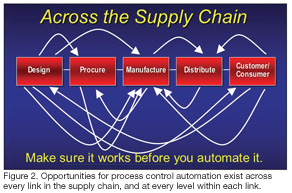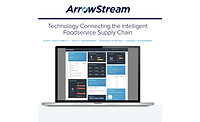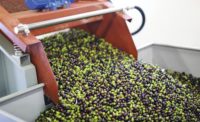Process control strategies and methods have come a long way in the last few decades, particularly with regard to the automation of these important manufacturing systems. Visual inspection and audit strategies that are the most common practices for verifying controls in the food manufacturing plant can be enhanced by the tidal wave of automated data collection devices and computerized management systems that offer greater efficiencies to your operation.
Powerful software programs and data collection devices are available for just about any aspect of process control that one could desire, from hand-held mobile auditor devices and time-and-temp and environmental monitoring units, to foreign material detection systems and packaging controls with built-in, transferable data collection capabilities, to laboratory information management systems (LIMS) and inventory management databases that enable systems analysis and process management. Since there are so many individual systems that can be automated, there are a tremendous number of data points that can be generated at any given time from any number of process points. The key to automating process control systems to increase efficiencies in production and the effectiveness of the total quality program is not the automation itself; rather, it is in determining the right data to collect that will permit the development of information that can be used to manage and to improve our processes.
So, how do we ensure that we can make sense of all the information to make meaningful and effective process control automation decisions? First, before purchasing data collection devices and installing computerized management systems, we need to consider the existing operation and desired information outcomes. Second, we should consider how to employ the concept of an integrated manufacturing quality management system based on a supply chain view of a food manufacturing operation to ensure that automated process controls ultimately provide the expected efficiencies.
Considerations for Automation
There are several considerations that will factor into your decision-making with regard to automating process control functions in your operation.
1. Make certain that your process control system works on paper before you automate it. As you begin to consider automating your operation’s process control system and the other operational systems that are affected by process controls, the first thing you should do is make certain that you understand what is going on in the existing process control or quality systems. Form a cross-functional team and look at the actual process control strategies and technologies in place and the data collection, management, reporting and action records that are currently used. Often, you will discover during this process that what you think is going on in terms of these activities is different in actual practice—and from what you’ve been discussing with your vendor as you are designing your new system. By outlining how the process currently works, it is easier to see where the process control data gaps exist in the operation and where automated data collection and management systems will have the most positive impact.
2. Integrate systems. You want to avoid causing staff to enter the same data in two separate places. Look at the opportunities to reduce duplication of efforts to gain greater efficiencies. For example, if you buy a LIMS, consider the efficiencies that can be achieved if you can automatically capture relevant data that exist in other business management databases, rather than having someone in the lab manually input the data into the LIMS system. The accounting department, for instance, may have a computerized Master File system in place that includes all sorts of data you require in the LIMS, such as a list of the products manufactured or product shelf life and age as a part of the inventory management system. Making sure that computerized management systems are capable of interdepartmental data transfer between systems is an excellent way to increase the value-add offered by automation.
Similarly, you need to understand the needs of the system users for successful integration. In other words, information must be collected at the correct level of detail for the user. It’s easy to buy a management system that feeds levels of detail that are acceptable to the accounting function but don’t work at all for the operations group, and vice versa. Don’t purchase software that is more complicated than you need but be aware of attaining a good operational fit that can be integrated with other functions within the organization.
3. Ensure that you will have access to ongoing technical support. It is enticing to think that you can install automated process control devices or systems and data collection or management software and that’s it, problem solved. However, products change, processes change, process controls change and therefore your automation strategies and needs will change. Find a way to make sure that as part of the purchase decision you fund the ability to have ongoing technical support, whether that be an external or internal resource. The day that you turn on the switch and the system goes live, you may find that you’ll want to make changes. It is best to have the resources to maintain the system and to accommodate those changes in the process that will surely arise over time.
4. Consider whether the systems/data support the timing and availability needs of operations. Most automated process control systems require maintenance, and if the business grows the maintenance and data collection/management requirements will change. For example, a two-shift, five-day-a-week operation that expands to operating seven days a week and 24 hours a day to accommodate orders will require that you take another look at both how data is uploaded from the plant floor to the corporate server, especially if you have multiple plants, and how you are going to run your operations while the system is being updated. Plan for a way to permit system maintenance before you go live.
5. Make sure that existing process control instrumentation will transfer data to new software applications. Make sure that the barcode readers, the scales, the vision systems, the metal detection systems—every instrument used for process control in your operation from which you gather data—will feed the software application that you are considering purchasing. With advance planning, you can avoid a situation in which the data management software is purchased but the scales (for example) that are supposed to automatically feed weight data to that package are not compatible and you find that buying new scales is the only solution.
6. Take a close look at the inventory control systems. With increasing requirements for traceability and compliance with elements of the Bioterror-ism Act, integrated systems to control inventory are probably more important to food companies than they have ever been. The automation of these systems is now imperative, and there are many things that should be considered when purchasing software for this function.
• Does the application really manage product code date? One of the things to look for is the software’s ability to actually track product code dates in these systems. Some systems that are available will only track product on a transaction date basis. Unfortunately, this means that a product with a “Use By” code date traveling from Point A to Point B receives a new date when it arrives at Point B and thus, the code date is lost. This can be resolved but you should be aware of this potential problem.
• Review physical identification capability (barcodes) against industry standards. Barcodes are very powerful tools that capture a lot of data, including when a product was made, what shift, what line, etc. Many food companies use barcodes internally to track product movement across different departments and areas of the plant. If the inventory control software is capable of including all the relevant information, locating product when needed is more effective.
• Will the product master support product variations without changing the SKU number? If the right product inventory software is purchased, it should allow you to address product differences without resorting to changing the product SKU. Let’s say your company produces an SKU that is coded with a data pack, and then a customer asks for that same product with a “Use By” code date, which means you have to create another SKU for that same product. By doing this, you are adding to the total number of SKUs that the company generates, and the multiple labels you will have to produce is driving complexity (and inefficiencies) into your business. This is a cost that you can avoid by using disposition codes, so it is advantageous to use an inventory control software package that will accommodate this.
The Supply Chain View
.jpg) Figure 1 shows a matrix illustrating a fundamental process control concept that can aid in the development of an integrated manufacturing quality management system based on a supply chain view of a food manufacturing operation to ensure that automated process controls ultimately provide the expected efficiencies and optimal results. The matrix shows the typical areas where process controls are employed. First the product is designed, then the necessary elements of the product such as ingredients, raw materials and packaging supplies are procured. The procured items are put together to make the product in the manufacturing phase, and once this is done, the product enters a distribution system and finally reaches the customer or consumer.
Figure 1 shows a matrix illustrating a fundamental process control concept that can aid in the development of an integrated manufacturing quality management system based on a supply chain view of a food manufacturing operation to ensure that automated process controls ultimately provide the expected efficiencies and optimal results. The matrix shows the typical areas where process controls are employed. First the product is designed, then the necessary elements of the product such as ingredients, raw materials and packaging supplies are procured. The procured items are put together to make the product in the manufacturing phase, and once this is done, the product enters a distribution system and finally reaches the customer or consumer.
As shown in Figure 1, we can measure the performance of these five steps against four metrics:
1. Cost. The costs associated with operations in each step of the process.
2. Quality. The quality parameters at each step in the operation. Note: This should be “quality” as defined by your customer. Find out what attributes are important about your product to your customer, whether that is a retailer, a consumer or another department within your organization.
3. Conformance. The conformance of the product to specifications and applicable regulations.
4. Service. This is a measurement of how well each of those steps are doing their job to supply the end product they produce to the next step in the chain.
Using this schematic, you can build a fairly simple matrix of measures across the supply chain that will describe every action and control function that occurs at a level that will allow you to measure your performance and take corrective action when trends are going in a different direction than you want them to. The measures you choose should be data driven and fact based. They should be supported by scientific literature or other documentation, as shown below the general matrix in Figure 1.
Let’s look at an example of building measures for various attributes from the food manufacturer’s perspective in the middle of the supply chain. Attribute measures will tell you what process control data points need to be collected, which will in turn provide you with valuable information about where automation will be most effectively employed to enhance process controls.
Procure. The food manufacturer’s process control matrix will include the need for operations to measure attributes of incoming ingredients and raw materials. This is a step where automating data collection is a good idea. Developing a database that includes data by raw material type and supplier, by weight and volume received, and by any attribute that helps you or the supplier obtain data that demonstrates the raw materials supplied are within agreed-to specifications. This database can be shared with suppliers to improve their performance and reduce variability in your manufacturing process. It can also help direct procurement staff to determine who they will purchase materials from or to eliminate underperforming suppliers. In a real sense, this is instituting process controls pre-manufacturing, which will have a positive impact throughout the entire manufacturing process.
Manufacture. In the manufacturing step, there are several metrics you can include, depending on your particular process, type of food manufacturing, process controls used, and so on. Some of the general metrics to consider are:
• Trend finished product proximate analyses. This information is good to collect and evaluate since these trends will indicate whether quality attributes or process control functions, for example, are actually being achieved. The trend analysis can often reveal ways to reduce variability, reduce costs and improve operational efficiencies.
• Establish yield standards for each manufacturing process step. If you have yield standards at each step in a process that is monitored on a daily basis, you will be able to compare that against the finished product trend analysis to help you understand what is really going on in your process.
• Evaluate package reject causes. If you have a packaging line that produces some number of rejects, you need to have some understanding of why those rejects are occurring and what you can do to reduce them. There are cases in which there has been product recontamination due to reject handling but companies focused on how to solve the recontamination as opposed to how to solve the reject issue. An effective process but gains made may be temporary as the true root cause of the problem was not addressed. Process control means reducing the numbers to begin with, so this may be a good place for automated monitoring that can provide you with the data you need to mitigate the problem.
• Install label control systems. Label controls relative to allergen-containing products, for example, is a significant issue for today’s food manufacturer. In all likelihood, you cannot get 100% perfect performance with manual or visual controls, so automated barcode and vision systems will likely offer you the extra 2%-3% detection rate that you can’t get with human control measures.
• Measure product attributes that have meaning to consumers. As you go through defining accept/reject criteria for products, or developing measures, make sure that you are placing emphasis on attributes that impact consumer liking. For instance, if salt is an attribute and changes can affect the flavor or performance of the product, then you should probably measure the salt content at a higher frequency than other attributes in the product.
• Sanitation effectiveness measures and pathogen environmental monitoring data are critically important in any process control strategy. These measures should be built into key performance indicators (KPIs) that are tracked weekly and managed for improvement.
• Finished product microbiological testing is good for validation of HACCP plans but not for routine control. However, when product is tested for pathogens, that product should be held until the results are available. This is a simple data point to include in process control management software programs, and a critical one.
• Monitor shelf life quality. This is another attribute that can be variable. It is vital that you know the product’s shelf life. It is not good enough to have your R&D department set a refrigerated meat product’s shelf life on an original measurement taken as a part of the design step. Too many things can happen to that product during processing and distribution that can change the shelf life of a product—and consumers will definitely let you know that your product is not achieving the date code you put on the package. Monitoring shelf life quality is a good process control metric that can be included in the computerized management system. This enables you to use statistics and evaluate that data to make code date changes to protect the quality of the product for your consumers.
Distribution. It’s a little more difficult for the manufacturer to get good attribute measurements and data at the product distribution step other than “orders filled, full and on time.” However, from a traceability perspective, obtaining data at this step in the food supply chain is important and can be accomplished with automated data collection devices that feed into a computerized database.
 As Figure 2 shows, the links of the supply chain and the levels of process control steps within each link are interconnected.
As Figure 2 shows, the links of the supply chain and the levels of process control steps within each link are interconnected.
Attribute measurements that you take and the data you collect and base process control decisions on can and do affect activities and decisions of others up and down the supply chain. If you make a change in the design of a product, it can affect the procurement and manufacturing metrics. If manufacturing changes the packaging line, it may affect how distribution handles the product. This is why it is important that you plan carefully on paper before automating any component of the process control systems to make sure it will work in your operation. Change is good but each link in the supply chain today requires good change.
John Weisgerber, President of Weisgerber Consulting LLC, is a specialist in food manufacturing practices and quality program development. With Kraft Foods for more than 33 years, Weisgerber held the position of Director, Quality at Kraft Foods in Madison, WI. He is affiliated with the American Meat Institute and has volunteered through the United Nations to provide food processing expertise to the government of Lesotho.
The author thanks Rod Von Behren and the staff of ROME Systems Inc. and Rick Collard of Mountain States Consulting, LLC for assistance in developing the content of this article.




